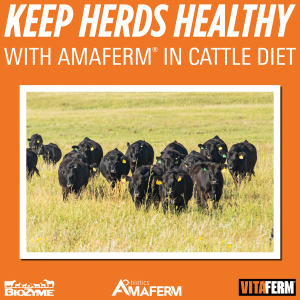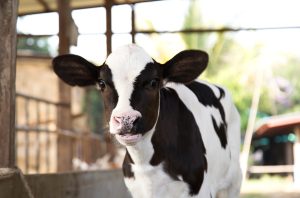
Hay for cattle plays a critical role in the diet, providing essential nutrients and a reliable feed source when pasture grasses are unavailable or insufficient. The importance of hay is especially evident when analyzed across the four seasons. Understanding how hay contributes to cattle nutrition year-round helps producers maintain healthy herds and ensure consistent production.
Cattle Nutrition Experts
Curious about who you’re getting advice from? VitaFerm® is a renowned brand of mineral supplements designed for beef cattle that maximize energy and forage utilization for successful production. Our products support cow-calf producers looking to maximize reproduction. Best of all, VitaFerm products ensure balanced nutrition for livestock.
VitaFerm is developed by BioZyme® Inc., a leading fermentation company pioneering advancements in animal nutrition and health. Through innovative research and high-quality manufacturing, BioZyme creates powerful solutions that improve animal performance and support producer profitability in the agricultural industry.
Our mission: undeniable positive impact on the health and wellness of your animals and your business.
Not only does hay play a critical role across the four seasons, but it also plays a vital part in the nutritional plan during the various reproductive phases. In this informational blog, let’s examine the importance of hay and the role it plays during the four seasons.
Winter: Hay Becomes a Primary Feed Source
In winter, hay becomes the cornerstone of the cattle’s diet. With pastures dormant or covered in snow, hay for cattle is often the only reliable feed source available. Cattle expend more energy in winter to maintain body heat, making a nutrient-rich diet essential. Hay provides the calories needed to sustain body condition during cold weather.
The high fiber content in hay supports rumen health and function. Proper digestion helps cattle extract maximum energy from their diet, which is particularly important during winter months. Consistent access to high-quality hay reduces stress on the herd during winter. Stress can weaken immune systems and lead to health issues, so providing a stable diet is vital for herd well-being
Different types of hay—such as alfalfa, clover or mixed-grass hay—can be used to tailor the diet based on the specific needs of your herd. For example, alfalfa hay, which is higher in protein and energy, should be fed to lactating cows or young calves.
Winter Hay Feeding Benefits
- Sustain Energy Needs
- Digestive Health/Temperature Regulation
- Minimize Stress
- Flexibility in Types for Maximum Nutrition
Spring: Transition to Fresh Forage
Spring marks a period of transition for cattle diets. As temperatures rise and grass begins to grow, cattle typically shift from a diet heavily dependent on hay to one that incorporates fresh forage. However, during the early part of spring, pastures might not produce enough grass to meet the herd’s nutritional needs. In this transitional phase, providing hay for cattle remains a necessary component of the diet.
In several regions, producers turn their herds to washy spring grass that is high in moisture and low in dry matter (DM) content. Use some carry-over higher-quality hay to increase the intake of DM, balance out any grass tetany issues or limit the intake of a lush legume to prevent bloat.
Hay provides the fiber and energy necessary to sustain cattle while pastures recover from winter dormancy. Cows’ energy needs are particularly high during calving season, which often coincides with early spring. Feeding hay for cattle ensures that lactating cows can produce adequate milk for their calves.
Additionally, spring weather can be unpredictable, with cold snaps or excessive rainfall hindering pasture growth. Hay is a dependable feed option when grazing conditions are less than ideal.
By supplementing with hay, producers can prevent overgrazing of pastures, allowing grasses to establish a strong root system and grow more robustly as the season progresses.
Spring Hay Feeding Benefits
- Additional Nutritional Support
- Prevent Overgrazing
- Dependable Feed Source During Unpredictable Weather
Summer: Supplement Pasture Grazing
During the summer, pasture grasses typically provide the bulk of a cattle’s diet. However, it can play an important supplemental feed in particular conditions.
In regions where summer droughts are common, pasture growth may slow or stop altogether. Hay becomes a vital feed source, ensuring that cattle receive adequate nutrition even when grazing is limited. Depending on the quality of the pasture, hay can be used to balance the diet. For example, if the available grass is low in protein or energy, high-quality hay can make up the deficit.
Certain groups within the herd, such as lactating cows or growing calves, may require more nutrients than pasture alone can provide. Hay supplementation ensures these animals meet their dietary requirements.
Summer Hay Feeding Benefits
- Drought Areas
- Nutrient Balance
- Specific Herd Needs – Lactation
Fall: Prepare for the Lean Months
Fall is a preparatory season, as producers begin to store hay for winter and adjust cattle diets in response to declining pasture quality. While temperatures drop, pasture grasses lose nutritional value. Hay provides a more consistent source of essential nutrients, such as fiber, protein and energy, which are crucial for maintaining body condition.
Many producers start weaning calves in the fall. During this time, calves require a high-quality diet to support growth and development. Hay is often included in their diet to provide the necessary nutrients.
Cattle producers focus on harvesting and storing hay during the fall to ensure a sufficient supply for the winter months. The quality of the hay harvested in the fall directly impacts the health and productivity of the herd during winter.
Fall Hay Feeding Benefits
- Decline in Forage Quality
- Weaning Calves
- Stockpiling Hay
Key Nutritional Benefits of Hay
Hay is more than a filler in the cattle diet. Hay for cattle provides essential nutrients that support overall health and productivity. These include:
Fiber
Hay is a rich source of dietary fiber, which is essential for maintaining proper rumen function and promoting efficient digestion. As a ruminant, fiber is necessary for proper digestion for cattle.
Protein
High-quality hay, such as alfalfa, is a significant source of protein. Protein supports muscle development, milk production and overall growth.
Energy
The carbohydrates in hay provide the energy cattle need for daily activities, reproduction and thermoregulation. Energy in hay helps prevent cold stress in cattle.
Minerals & Vitamins
Depending on the type of hay, it can supply important minerals like calcium and phosphorus, as well as vitamins A and E.
Challenges & Considerations
While hay for cattle is vital for all seasons, it comes with challenges that producers must navigate.
Storage
Proper storage is essential to prevent spoilage and maintain hay quality. Moisture and exposure to the elements can lead to mold growth, reducing nutritional value and posing health risks to cattle. Testing moisture in hay is an important part of the storage process.
Cost
Producing or purchasing hay can be expensive, especially in regions where drought or other factors limit supply. Cattle producers must balance costs with the nutritional benefits of high-quality hay.
Quality Control
Not all hay is created equal. The nutrient content of hay varies based on factors such as the type of grass or legume, the stage of maturity at harvest and storage conditions. Regular hay testing and careful selection are necessary to ensure the hay meets the herd’s nutritional needs.
Hay testing is a service that BioZyme offers its customers. Once hay samples are collected by our dealers or ASMs and submitted for testing, our on-staff nutritionists analyze the results. Those results are shared with the customers to determine the best times to feed particular lots of hay and how to supplement each lot.
VitaFerm can Help
Regardless of the season of the year or the production cycle your herd is in, VitaFerm makes a mineral for your operation. If it’s winter and you are feeding hay to lactating cows, we’ve got your reproductive needs covered with VitaFerm® Concept•Aid® or VitaFerm® ReproMaxx®.
If your calves are freshly weaned, and your cows are in maintenance, or their lowest nutritional requirements, we also make supplements that can help your herd. Look no further than VitaFerm® ONE or VitaFerm Conserve®.
Each of the VitaFerm lines is powered by AO-Biotics® Amaferm®, a research-proven prebiotic designed to enhance digestibility. Amaferm is the key additive in all VitaFerm products. It has more than 150 published and/or presented research studies proving its increase in digestibility and, ultimately, its impact on the animal. Not only will you be supplementing your cows’ vitamin and mineral needs, but you will be providing them with Amaferm.
The key point of Amaferm is using it as a tool to get more energy metabolized by the cow. More forage digestibility leads to less physical fill, so she can eat more. More VFA production provides the extra energy needed for thermoregulation, which will also help keep her warm in the cold winter months.
“Amaferm can help unlock the nutritional value of all types of forages. Amaferm goes beyond stimulating the growth of beneficial rumen bacteria and can also promote rumen fungal growth and enzymatic activity. This increases fiber digestibility and volatile fatty acid (VFA) production by 17% and 16%, respectively. As such, more energy becomes available to your cows, leading to more performance,” said Chris Cassady, Ph.D., BioZyme Director of Beef Technical Sales.
Amaferm also helps your feedstuffs and forages go further, helping decrease the overall cost.
The Final Word
Hay for cattle is an essential part of their diet, providing critical nutrients and serving as a dependable feed source throughout the year. Its importance varies by season, from supporting the transition to fresh forage in spring to sustaining the herd during the harsh winter months, often during lactation.
By understanding the role of hay in cattle nutrition and managing its use effectively, producers can ensure their herds’ health, productivity and well-being year-round. They can also more efficiently build a supplement program including valuable, balanced nutrition to offset the nutrient value in their hay.
Get your VitaFerm Today
At BioZyme, we give you options within the VitaFerm brand. Not sure what to feed cows when it comes to the VitaFerm line? Check out our Concept•Aid Product Navigator. Remember, hay testing is another resource that we offer our customers. It is an important step to offering hay for cattle through the seasons.
Get your VitaFerm products from an authorized BioZyme dealer today. Our extensive dealer network is here to help you meet mineral needs.
Want to learn more about VitaFerm and our other products? Sign up for our electronic newsletter to stay in the know!


